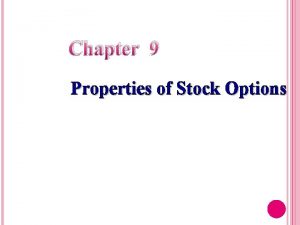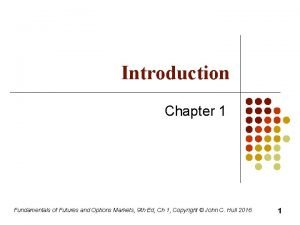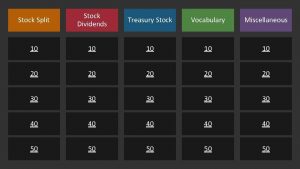X ACCOUNTING FOR STOCK OPTIONS Introduction Stock options














- Slides: 14

X. ACCOUNTING FOR STOCK OPTIONS

Introduction • Stock options are derivative financial instruments that corporations grant as an incentive to various individuals, primarily employees. A stock option gives the option holder the right (but not the obligation) to purchase a certain number of shares of stock at a fixed price (“strike price”).

The Mechanics of A Stock Option • a corporation grants some of its employees the right to purchase shares of stock at a future date (the grant date) • the plan specifies a period during which employees must remain employed at the corporation • after this service period, the stock options vest, and the employees may exercise the options at the preselected price • however, employees must purchase the stock before the option to exercise expires

History of Accounting for Stock Options • The use of stock options as an alternative to traditional compensation schemes skyrocketed during the 1980 s. • corporations directed large sums of money to their key employees through the use of stock options. • however, the corporations did not record the compensation expense associated with the options. • GAAP did not require expensing

FASB Proposes Standard Requiring Expensing • FASB Supporters – Stock is a right to participate in a corporations future cash flows – The right to buy the stock below market value is merely an indirect form of compensation – As such, the difference between the stock’s fair market value and the option price should be treated as compensation and expensed

FASB Proposes Standard Requiring Expensing • Opponents to FASB proposal – Corporations and business groups argued that any value inherent in a stock option is merely an opportunity cost--an opportunity that the corporation could have pursued but for the employee stock option. – Since historically, the FASB had never required corporations to recognize expenses associated with missed opportunities, the accounting for stock options should not be based on lost opportunities. – They also argued that this change would have a chilling effect on the ability of entrepreneurial start-up companies to obtain capital because the change lowers income making it more difficult to attract investors. – Alternatively, they argued that the new proposed rules would discourage corporations from offering employee stock options, which would be unfortunate, since these plans are very effective in creating incentives and productivity among employees.

Result • In response to intense political pressure, the FASB ultimately abandoned its efforts to force all corporations to recognize the value inherent in a stock option as an expense. • Instead, FAS-123 merely sets forth optional accounting methods that are "encouraged, " but not required, by the FASB.

Accounting for Stock Options • It took the corporate scandals of 2002 to spur the current and more accurate accounting treatment of stock options. Financial accounting for employee stock option plans reflects a long, controversial history, allowing companies to avoid reporting stock options issued to employees as compensation expense. In contrast, GAAP now requires entities to adopt an approach that effectively requires recognition of expense on the issuance of stock options to employees

Enron Accounting for Post Employee Stock Option Plans • Accounting for stock options requires measuring compensation based on the “fair value” of the stock options in on the date granted. This amount is recorded as compensation expense deducted on the period starting with the date the options are granted ending when the options vest and can be exercised. However, the compensation amount may be reduced based on the entities’ experience of forfeitures. Be aware—current accounting for stock options does not impact cash —only income statement expenses. • The fair value of an option is (1) its intrinsic value (fmv at grant date less the option price on same date) plus (2) its time value of money component plus (3) its volatility component (the amount by which the stock is expected to fluctuate in the future). • Estimating the fair value of stock options require the use of pricing models that take the following into account: (1) expected term of the option; (2) base price; (3) current market price of the stock; (4) volatility of the stock; (5) expected dividends; (6) expected risk-free rate of return during the terms of the option.

Example • Suppose that ABC Corp. institutes a noncompensatory employee stock option plan. ABC Corp. operates with 20 full-time employees, and all are entitled to participate in the plan. • On January 1, ABC Corp. grants 20 stock options to each of its employees. Each option vests 4 years from the grant date, January 1, and entitles the employee to purchase 20 shares of ABC Corp. 's common stock ($1 par value) for a price of 90% of the market value of the stock on the date the option is granted. The option may be exercised for a three-year period, after the options vest.

Example • The market value of the stock on the date the option is granted, January 1, is $50. Thus, the exercise price at which employees may purchase the shares is $45 per share. The fair value of the options, using an accepted option pricing model, is $3 per option. • The first day after the options vest and through the next three years, all 20 employees exercise their options to purchase 20 shares of ABC Corp. 's common stock. Thus, the employees collectively acquire 400 shares, paying $45 per share for a total of $18, 000. The market value of the stock when the employees exercise the options is $52 per share (the stock had gone up $2 per share). • Thus, the benefits accruing to the employees from the option arrangement is $7 per share ($52 market price less $45 option exercise price), times 400 shares equals $2, 800.

Accounting Entries • ABC Corp. would record these transactions in the following journal entries: DATE TRANSACTION DEBIT Jan. 1 Grant of options to employees. No entry is required. CREDIT

Accounting Entries Under FASBASC 240 code, ABC Corp. would typically record these transactions in the following journal entries: DATE TRANSACTION Dec. 31, 20 X 2, 20 X 3, 20 X 4 Compensation Expense DEBIT CREDIT 300 Paid-In Capital 300 To record compensations of stock options: ach option is believed to have a fair value based on accepted pricing models of $3 each on January l, when 400 options were granted to employees. Calcuate total compensation expense. Compensation expense is then allocated over the 3 -year period before vesting. Jan. 1, 20 X 4 – Dec. 31, 20 X 6 Cash (400 shares x $45/share) Common stock ($1 x 400) Paid In Capital (amount paid in excess of par) To record when the options are exercised and stock is issued. 18, 000 400

Estimated Forfeitures • Compensation expense recorded when stock options are granted, may require adjustment based on corps previous experience with forfeitures. In other words, if a material number of options issues are forfeited before vesting (e. g. , employee turnover or breach of contract terms), the entity may have to reduce the amount expensed on the grant dated to reflect this experience.
 Bmy finviz
Bmy finviz Properties of stock options
Properties of stock options Stock options terminology
Stock options terminology Options on stock indices and currencies
Options on stock indices and currencies Introduction to futures and options
Introduction to futures and options Fspos
Fspos Typiska drag för en novell
Typiska drag för en novell Tack för att ni lyssnade bild
Tack för att ni lyssnade bild Returpilarna
Returpilarna Shingelfrisyren
Shingelfrisyren En lathund för arbete med kontinuitetshantering
En lathund för arbete med kontinuitetshantering Särskild löneskatt för pensionskostnader
Särskild löneskatt för pensionskostnader Tidbok
Tidbok A gastrica
A gastrica Vad är densitet
Vad är densitet



























